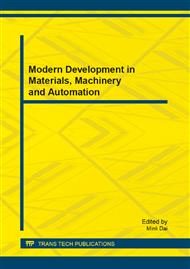p.15
p.23
p.29
p.35
p.45
p.53
p.59
p.65
p.69
A New Approach for Chatter Prediction in Robotic Milling Based on Signal Processing in Time Domain
Abstract:
Robotic machining is an attractive, cost-effective, and flexible alternative for basic machining applications. Having these characteristics, industrial robots are assumed to be the next generation of machine tools. But, due to weaker structure of robotic manipulators in comparison to conventional CNC machines, robotic machining processes are more subject to unwanted detrimental vibrations. At this work, simulations are realized in Time-Domain using the linearized robot structure model as transfer function of chatter block diagram and end milling force as machining force model. This article presents a new technique for simulating and analyzing the possibility of happening chatter vibrations at different values of machining parameters considering structure and configuration of the studied robot. Results show that limit of chatter occurrence is dramatically affected by changing robotic machining configuration.
Info:
Periodical:
Pages:
45-51
Citation:
Online since:
August 2013
Price:
Сopyright:
© 2013 Trans Tech Publications Ltd. All Rights Reserved
Share:
Citation:


